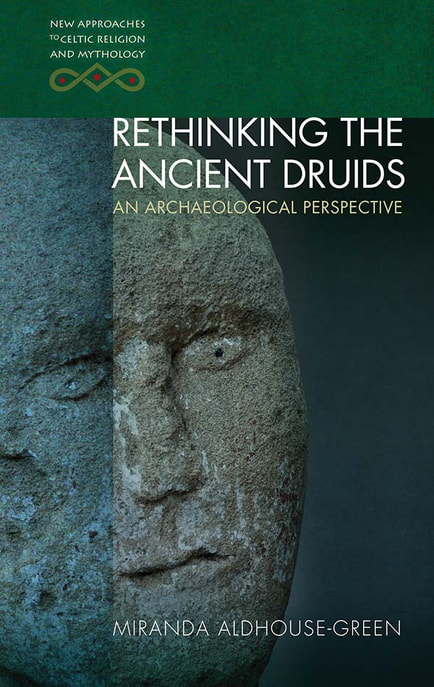
TITLE: Rethinking the Ancient Druids
AUTHOR: Miranda Aldhouse-Green
PUBLISHER: University of Wales Press
ISBN: 9781786837974
PODCAST EPISODE: None
REVIEWER: Hilary Wilson
Nora Chadwick’s 1996 work The Druids analyzed the bulk of the historical literature that made reference to the ancient class. Her translations and textual criticism are still invaluable to scholars today, in spite of some of her more unusual conclusions in regards to the ancient druids - namely that they were a purely philosophical order rather than a religious one.. In 2021, Miranda Aldhouse-Green released her companion piece to Chadwick’s original book. Rethinking The Ancient Druids: An Archaeological Perspective, published by the University of Wales Press, builds upon Chadwick’s original work by focusing upon recent archaeological finds and whether they support or refute what literary sources have taught us about the ancient druids.
Miranda Aldhouse-Green set herself the unenviable task of contextualizing the druids within their own time. Doing this sets the focus primarily upon the first couple of centuries BCE/CE, and she does an astonishing job synthesizing what the indigenous religions might have been throughout the Celtic world. Anyone with a passing interest in the study of Celtic religions is likely familiar with Aldhouse-Green’s work in the area, and she does no lesser job now of bringing to life what we know of this religion - and refuting some common misconceptions.
One of the interesting things that Aldhouse-Green brings to light is the survival of these indigenous beliefs into Roman times. She argues for examples and evidence of syncretism that developed, as well as the Gallic gods continuing to be worshiped underground in some areas into the 400s CE. It’s fascinating to see the evidence of it all play out, and the way that the evidence is analyzed in such an accessible way. Furthermore, her previous writings on the bog bodies come into play in her discussion of human sacrifice among the various tribes. Once more, recent archaeological evidence changes the view, by creating an interesting argument that some of the better examples may have been aversion sacrifices to drive the encroaching Roman armies away.
Rethinking the Ancient Druids is a truly invaluable resource for those interested in Celtic studies. While it is a scholarly text, it is by no means inaccessible to the general public. It is rife with beautiful photos of archaeological artefacts that the general public might not otherwise get a chance to see. The bibliography and thorough notes should provide any curious reader with a far larger reading list, while also attesting to the deep level of research that Aldhouse-Green has done. While we may never know precisely who the ancient druids were, and what they believed - this book does provide a more thorough and precise understanding of them than we have previously had. Like Chadwick’s book before, this one shall certainly turn into a classic within its field.
AUTHOR: Miranda Aldhouse-Green
PUBLISHER: University of Wales Press
ISBN: 9781786837974
PODCAST EPISODE: None
REVIEWER: Hilary Wilson
Nora Chadwick’s 1996 work The Druids analyzed the bulk of the historical literature that made reference to the ancient class. Her translations and textual criticism are still invaluable to scholars today, in spite of some of her more unusual conclusions in regards to the ancient druids - namely that they were a purely philosophical order rather than a religious one.. In 2021, Miranda Aldhouse-Green released her companion piece to Chadwick’s original book. Rethinking The Ancient Druids: An Archaeological Perspective, published by the University of Wales Press, builds upon Chadwick’s original work by focusing upon recent archaeological finds and whether they support or refute what literary sources have taught us about the ancient druids.
Miranda Aldhouse-Green set herself the unenviable task of contextualizing the druids within their own time. Doing this sets the focus primarily upon the first couple of centuries BCE/CE, and she does an astonishing job synthesizing what the indigenous religions might have been throughout the Celtic world. Anyone with a passing interest in the study of Celtic religions is likely familiar with Aldhouse-Green’s work in the area, and she does no lesser job now of bringing to life what we know of this religion - and refuting some common misconceptions.
One of the interesting things that Aldhouse-Green brings to light is the survival of these indigenous beliefs into Roman times. She argues for examples and evidence of syncretism that developed, as well as the Gallic gods continuing to be worshiped underground in some areas into the 400s CE. It’s fascinating to see the evidence of it all play out, and the way that the evidence is analyzed in such an accessible way. Furthermore, her previous writings on the bog bodies come into play in her discussion of human sacrifice among the various tribes. Once more, recent archaeological evidence changes the view, by creating an interesting argument that some of the better examples may have been aversion sacrifices to drive the encroaching Roman armies away.
Rethinking the Ancient Druids is a truly invaluable resource for those interested in Celtic studies. While it is a scholarly text, it is by no means inaccessible to the general public. It is rife with beautiful photos of archaeological artefacts that the general public might not otherwise get a chance to see. The bibliography and thorough notes should provide any curious reader with a far larger reading list, while also attesting to the deep level of research that Aldhouse-Green has done. While we may never know precisely who the ancient druids were, and what they believed - this book does provide a more thorough and precise understanding of them than we have previously had. Like Chadwick’s book before, this one shall certainly turn into a classic within its field.